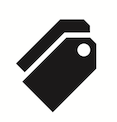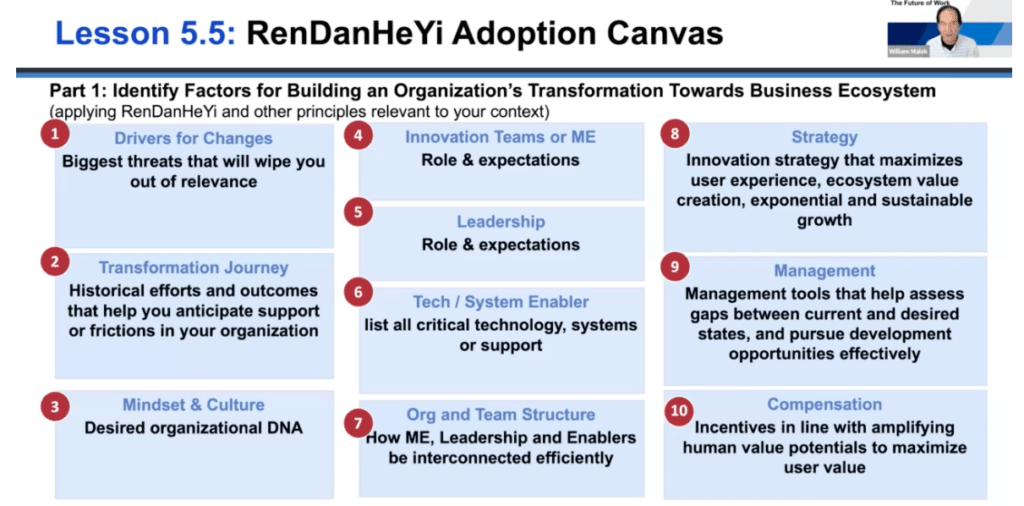The Business Model Canvas was created by Alexander Osterwalder, of Strategyzer®. The canvas provides a one-page primer and template for analysis. Questions and points of view are detailed below.[1] We offer it to support the MGRUSH Business Analyst community. Please modify each and all of the following to help your situation.
UPDATE: MGRUSH has released its Meeting Pathway (infographic guideline) and Workshop Canvas (37 open-ended preparatory questions). Consequently, the Meeting Pathway details a comprehensive meeting and workshop preparation approach that you can now download.
Business Model Canvas — Agenda Steps and Questions to be Addressed

-
Business Model Canvas: Partners
- Who are our significant partners?
- Who are our significant suppliers?
- What critical activities do our partners perform?
- What necessary resources are we acquiring from our suppliers?
- Value-add from partnerships
- Acquisition of specialized resources and activities
- Optimization and economy
- Reduction of risk and uncertainty
- Value-add from partnerships

-
Business Model Canvas: Activities
- What significant activities do our value propositions require?
- Which activities are the primary drivers of customer relationships?
- Where does our distribution channel provide value-add?
- What are the revenue streams for each channel?
- Categories
- Production activities
- Problem-solving activities
- Platform/ network
- Categories

-
Business Model Canvas: Resources
- What significant resources do our value propositions require?
- Which significant resources do our distribution channels require?
- What significant resources do our customer relationships require?
- Which significant resources do our revenue streams require?
- Types of resources
- Financial
- Human
- Intellectual (patents, copyrights, data, etc.)
- Physical
- Types of resources

-
Business Model Canvas: Value Propositions
- What value do we deliver to our customers?
- Which customer needs are we satisfying?
- Which customer problems are we helping to solve?
- What bundles of products and services are we offering to each customer segment?
- Characteristics
- Brand/ status
- Customization
- Design
- “Getting the Job Done”
- Newness
- Performance
- Characteristics

-
Business Model Canvas: Customer Relationships
- What type of relationships do each of our primary customer segments expect us to build and maintain with them?
- Which ones have we established?
- How are they integrated with the rest of our business model?
- How costly are they?
- Examples
- Automated services
- Co-creation
- Communities
- Dedicated personal assistance
- Personal assistance
- Self-service
- Examples

-
Business Model Canvas: Channels
- Through which channels do our primary customer segments want to be reached?
- How are we reaching them now?
- How are our channels integrated?
- Which channels work best?
- Which channels are most cost-efficient?
- How are we integrating them with customer routines?
- Channel phases
- Awareness
- How do we raise awareness about our company’s products and services?
- Evaluation
- How do we help customers evaluate our organization’s value propositions?
- Purchase
- How do we allow customers to purchase specific products and services?
- Delivery
- How do we deliver a value proposition to our primary customer segments?
- After-sales
- How do we provide post-purchase customer support?
- Awareness
- Channel phases

-
Business Model Canvas: Customer Segments
- For whom are we creating value?
- Who are our most important customers?
- Diversified
- Mass market
- Multi-sided platform
- Niche market
- Segmented

-
Business Model Canvas: Cost Structure
- Which costs are most critical to our business structure?
- What primary resources are the most expensive?
- What primary activities are the most expensive?
- Is your business more…
- Cost-driven (leanest cost structure, low price value proposition, maximum automation, extensive outsourcing)
- Value-driven (focused on value creation, premium value proposition)
- Sample characteristics
- Economies of scale
- Economies of scope
- Fixed costs (salaries, rents, utilities)
- Variable costs
- Is your business more…

-
Business Model Canvas: Revenue Streams
- For what value are our customers willing to pay?
- For what value do they currently pay?
- How are they currently paying?
- What method would they prefer for paying?
- How much does each revenue stream contribute to overall revenues?
- Types
- Advertising
- Asset sale
- Brokerage fees
- Lending/ renting/ leasing
- Licensing
- Subscription fees
- Usage fee
- Fixed pricing
- Customer segment dependent
- List price
- Product feature dependent
- Volume dependent
- Dynamic pricing
- Negotiating (bargaining)
- Real-time market
- Yield management
- Types

By Business Model Alchemist – http://www.businessmodelalchemist.com/tools, CC BY-SA 1.0, http://commons.wikimedia.org/w/index.php?curid=11892574
For a more thorough discussion around business ideas and additional context around the Canvas, turn to “The Entrepreneur’s Foolproof 5-Step Guide to Finding and Validating Business Ideas”.
[1] The Business Model Canvas and Meeting Pathway and Meeting Canvas are licensed under the Creative Commons Attribution-Share Alike 1.0 Generic license and thus available for restricted distribution
RenDanHeYi Adoption Canvas
ALTERNATIVELY — CONSIDER THE QUANTUM MANAGEMENT APPROACH THAT FOLLOWS:
______
Don’t ruin your career by hosting bad meetings. Sign up for a workshop or send this to someone who should. MGRUSH workshops focus on meeting design and practice. Each person practices tools, methods, and activities daily during the week. Therefore, while some call this immersion, we call it the road to building high-value facilitation skills.
Our workshops also provide a superb way to earn up to 40 SEUs from the Scrum Alliance, 40 CDUs from IIBA, 40 Continuous Learning Points (CLPs) based on Federal Acquisition Certification Continuous Professional Learning Requirements using Training and Education activities, 40 Professional Development Units (PDUs) from SAVE International, as well as 4.0 CEUs for other professions. (See workshop and Reference Manual descriptions for details.)
Want a free 10-minute break timer? Sign up for our once-monthly newsletter HERE and receive a free timer along with four other of our favorite facilitation tools.
_____
With Bookmarks no longer a feature in WordPress, we need to append the following for your benefit and reference
- 20 Prioritization Techniques = https://foldingburritos.com/product-prioritization-techniques/
- Creativity Techniques = https://www.mycoted.com/Category:Creativity_Techniques
- Facilitation Training Calendar = https://mgrush.com/public-facilitation-training-calendar/
- Liberating Structures = http://www.liberatingstructures.com/ls-menu
- Management Methods = https://www.valuebasedmanagement.net
- Newseum = https://www.freedomforum.org/todaysfrontpages/
- People Search = https://pudding.cool/2019/05/people-map/
- Project Gutenberg = http://www.gutenberg.org/wiki/Main_Page
- Scrum Events Agendas = https://mgrush.com/blog/scrum-facilitation/
- Speed test = https://www.speedtest.net/result/8715401342
- Teleconference call = https://youtu.be/DYu_bGbZiiQ
- The Size of Space = https://neal.fun/size-of-space/
- Thiagi/ 400 ready-to-use training games = http://thiagi.net/archive/www/games.html
- Visualization methods = http://www.visual-literacy.org/periodic_table/periodic_table.html#
- Walking Gorilla = https://youtu.be/vJG698U2Mvo

Terrence Metz, president of MG RUSH Facilitation Training, was just 22-years-old and working as a Sales Engineer at Honeywell when he recognized a widespread problem—most meetings were ineffective and poorly led, wasting both time and company resources. However, he also observed meetings that worked. What set them apart? A well-prepared leader who structured the session to ensure participants contributed meaningfully and achieved clear outcomes.
Throughout his career, Metz, who earned an MBA from Kellogg (Northwestern University) experienced and also trained in various facilitation techniques. In 2004, he purchased MG RUSH where he shifted his focus toward improving established meeting designs and building a curriculum that would teach others how to lead, facilitate, and structure meetings that drive results. His expertise in training world-class facilitators led to the 2020 publication of Meetings That Get Results: A Guide to Building Better Meetings, a comprehensive resource on effectively building consensus.
Grounded in the principle that “nobody is smarter than everybody,” the book details the why, what, and how of building consensus when making decisions, planning, and solving problems. Along with a Participant’s Guide and supplemental workshops, it supports learning from foundational awareness to professional certification.
Metz’s first book, Change or Die: A Business Process Improvement Manual, tackled the challenges of process optimization. His upcoming book, Catalyst: Facilitating Innovation, focuses on meetings and workshops that don’t simply end when time runs out but conclude with actionable next steps and clear assignments—ensuring progress beyond discussions and ideas.



